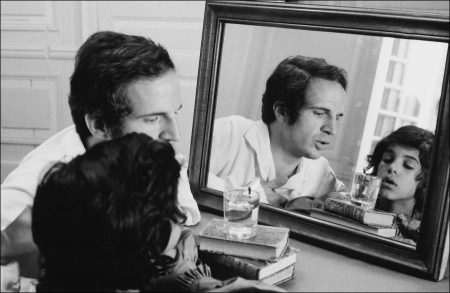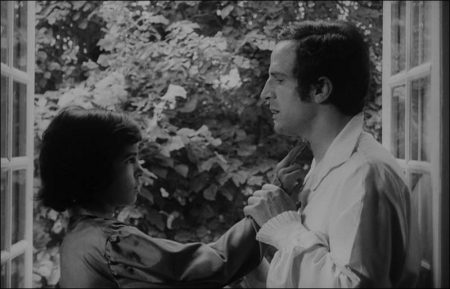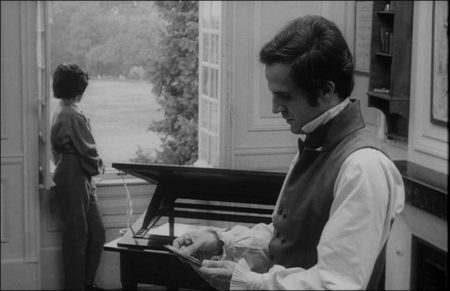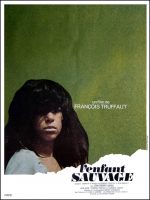Taglines: At last an adult film to which you can take your children.
L’Enfant Sauvage is set in the 18th century. A young boy (Jean-Pierre Cargol) is found in the forest near Aveyron. The child was discovered after living in the wild for the first several years of his life, so he is placed under the supervision of Dr. Jean Itard. Itard (François Truffaut) names the boy Victor and observes the child’s attempt to survive in his new, unknown world.
There’s a narrow margin between the civilized aspects of rough Parisian life and the brutal laws of life in nature. Victor finds a sort of equilibrium in the windows that mark the transition between the closed interiors and the world outside. Candles and mandoline airs also have an effect on him. But Victor gains his ability to have social relations by losing his capacity to live as a savage.
L’Enfant Sauvage (English: The Wild Child, released in the United Kingdom as The Wild Boy) is a 1970 French film by director François Truffaut. Featuring Jean-Pierre Cargol, François Truffaut, Françoise Seigner and Jean Dasté, it tells the story of a child who spends the first eleven or twelve years of his life with little or no human contact. It is based on the true events regarding the child Victor of Aveyron, reported by Jean Marc Gaspard Itard. The film sold nearly 1.5 million tickets in France.
The Wild Child was released in the middle of the “flower child” era, which favored the Romantic idea of the “noble savage” over rationalism and civilization. The term “noble savage” is derived from John Dryden’s The Conquest of Granada and the Rousseauian idea of humans being basically good in their most primitive state that had long been championed by Romantics and hippies. Many viewers interpreted the film in this way when first viewing it, but many critics and spectators began to notice that Truffaut seemed to be criticizing the concept of the “noble savage” and taking the side of the rationalists.
In a publicity release for the film, Truffaut wrote “From Romulus and Remus through Mowgli and Tarzan, men have continually been fascinated by tales of beast children. It may be that in these stories of abandoned infants, reared by wolves, bears, or apes, they see a symbol of the extraordinary destiny of our race. Or it may be simply that they harbor a secret hankering after a natural existence.”
Film critic Mireille Amiel was disappointed by this aspect of the film and by Truffaut, asking “How can the rebel of The 400 Blows place himself alongside the oppressor, even one as sympathetic as Itard?” and adding “the astonishing thing is that Truffaut the filmmaker is better than Truffaut the man, and that we can accept the interest and beauty of this film at the same time that we’re violently opposed to its content.”
In the film, when Victor is first found he is covered with scars from conflict with other animals in the wild, and Truffaut’s interpretation makes it clear that civilization, and especially human communication, is a far better life for Victor than in the wild.
Filming took place on location in Aveyron, France, from July to August 1969, so as not in interrupt Cargol’s education.[18] It was Truffaut’s first film with cinematographer Néstor Almendros, who went on to work with Truffaut on eight more films. The film included several references to the aesthetics of silent films, such as using an iris shutter to end scenes and filming it in black and white and in 1.33 “academy aspect ratio”. Truffaut directed first-time actor Cargol by instructing him to pretend to be different animals or people during specific scenes, such as “be like a dog”, or “like a horse”, or even “like Harpo Marx.”
During the shoot, Cargol was given a 8mm camera and stated that he would become “the first gypsy director”, however Cargol only appeared as an actor in one more film. Truffaut later said that during the making of the film he “saw that the cinema helped his evolution. In my opinion, the difference between Jean-Pierre Cargol before the film and after it is astonishing.”
Truffaut had scripted a sequence in which Victor is depicted struggling against the harsh weather conditions of winter in the wild, but budgetary limitations forced him to cut out the scenes. The film has very little dialogue and is mostly dominated with Itard’s voice-over, making it close to a silent film. The use of iris-ing in and out of Victor not only reinforced the film’s affinity with silent films, but often symbolized Victor’s coming out of and going into darkness. The film’s music was arranged by Antoine Duhamel and consists of music by Antonio Vivaldi.
After filming was completed, Truffaut realized that The Wild Child had a strong connection to his first film The 400 Blows, not just for its depicting of frustrated children but because it mirrored his experience working with then first time actor Jean-Pierre Léaud. Truffaut said that “I was reliving somewhat the shooting of The 400 Blows, during which I initiated Jean-Pierre Léaud into cinema. I basically taught him what cinema was.”
Truffaut then decided to dedicate the film to Léaud. He later added that he “realized that L”Enfant Sauvage is bound up with both Les Quatre Cent Coups and Fahrenheit 451. In Les Quatre Cents Coups I showed a child who missed being loved, who grows up without tenderness; in Fahrenheit 451 it was a man who longed for books, that is, culture. With Victor of Aveyron, what is missing is something more essential – language.”
Truffaut also considered the making of the film to be a growing experience for him as a person and as a filmmaker, stating that “until The Wild Child, when I had children in my films, I identified with them, but here, for the first time, I identified with the adult, the father.” After the film was released, Truffaut told a reporter “I did not want to spell out my message. It is simply this: man is nothing without other men.”
L’Enfant Sauvage (1970)
Directed by: François Truffaut
Starring: Jean-Pierre Cargol. François Truffaut, Françoise Seigner, Jean Dasté, Annie Miller, Claude Miller, Paul Villé, Nathan Miller, Mathieu Schiffman, Jean Gruault, Robert Cambourakis
Screenplay by: François Truffaut, Jean Gruault
Production Design by: Armand Barbault
Cinematography by: Néstor Almendros
Film Editing by: Agnès Guillemot
Costume Design by: Gitt Magrini
Set Decoration by: Jean Mandaroux
Music by: Antonio Vivaldi
MPAA Rating: None.
Distributed by: United Artists
Release Date: February 26, 1970 (France), September 9, 1970 (United States)
Views: 385











